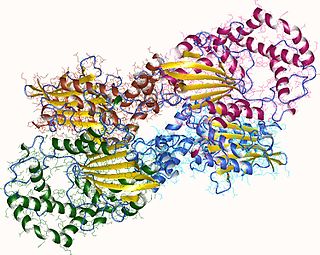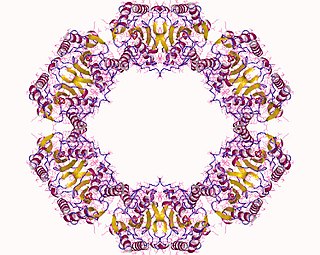
In biochemistry, a phosphatase is an enzyme that uses water to cleave a phosphoric acid monoester into a phosphate ion and an alcohol. Because a phosphatase enzyme catalyzes the hydrolysis of its substrate, it is a subcategory of hydrolases. Phosphatase enzymes are essential to many biological functions, because phosphorylation and dephosphorylation serve diverse roles in cellular regulation and signaling. Whereas phosphatases remove phosphate groups from molecules, kinases catalyze the transfer of phosphate groups to molecules from ATP. Together, kinases and phosphatases direct a form of post-translational modification that is essential to the cell's regulatory network.

Glucose 6-phosphate is a glucose sugar phosphorylated at the hydroxy group on carbon 6. This dianion is very common in cells as the majority of glucose entering a cell will become phosphorylated in this way.

In biochemistry, phosphorylases are enzymes that catalyze the addition of a phosphate group from an inorganic phosphate (phosphate+hydrogen) to an acceptor.

The enzyme glucose 6-phosphatase (EC 3.1.3.9, G6Pase; systematic name D-glucose-6-phosphate phosphohydrolase) catalyzes the hydrolysis of glucose 6-phosphate, resulting in the creation of a phosphate group and free glucose:

Acid phosphatase is an enzyme that frees attached phosphoryl groups from other molecules during digestion. It can be further classified as a phosphomonoesterase. It is stored in lysosomes and functions when these fuse with endosomes, which are acidified while they function; therefore, it has an acid pH optimum. This enzyme is present in many animal and plant species.

D-Xylulose 5-phosphate (D-xylulose-5-P) is an intermediate in the pentose phosphate pathway. It is a ketose sugar formed from ribulose-5-phosphate by ribulose-5-phosphate epimerase. In the non-oxidative branch of the pentose phosphate pathway, xylulose-5-phosphate acts as a donor of two-carbon ketone groups in transketolase reactions.

In enzymology, a nucleoside-diphosphatase (EC 3.6.1.6) is an enzyme that catalyzes the chemical reaction
The enzyme 2-deoxyglucose-6-phosphatase (EC 3.1.3.68) catalyzes the reaction
The enzyme fructose-2,6-bisphosphate 6-phosphatase (EC 3.1.3.54) catalyzes the reaction
The enzyme glucose-1-phosphatase (EC 3.1.3.10) catalyzes the reaction
The enzyme [glycogen-synthase-D] phosphatase ({EC 3.1.3.42) catalyzes the reaction

The enzyme Inositol phosphate-phosphatase is of the phosphodiesterase family of enzymes. It is involved in the phosphophatidylinositol signaling pathway, which affects a wide array of cell functions, including but not limited to, cell growth, apoptosis, secretion, and information processing. Inhibition of inositol monophosphatase may be key in the action of lithium in treating bipolar disorder, specifically manic depression.
The enzyme phosphatidylinositol-3,4,5-trisphosphate 3-phosphatase (EC 3.1.3.67) catalyzes the chemical reaction
The enzyme phosphatidylinositol-3,4-bisphosphate 4-phosphatase (EC 3.1.3.66) that catalyzes the reaction
The enzyme phosphatidylinositol-3-phosphatase (EC 3.1.3.64) catalyzes the reaction
The enzyme streptomycin-6-phosphatase (EC 3.1.3.39) catalyzes the reaction
The enzyme sugar-phosphatase (EC 3.1.3.23) catalyzes the reaction

Glucose-6-phosphatase, catalytic subunit is an enzyme that in humans is encoded by the G6PC gene.

Glucose-6-phosphatase 2 is an enzyme that in humans is encoded by the G6PC2 gene.

The enzyme protein serine/threonine phosphatase is a form of phosphoprotein phosphatase that acts upon phosphorylated serine/threonine residues:











